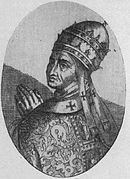Dean Giovanni Boccamazza Date 22 October 1803 Protodeacon Matteo Rosso Orsini | Ballots 1 Camerlengo Teodorico Ranieri | |
 | ||
Papal conclave 1303
The papal conclave, 1303 elected Pope Benedict XI to succeed Pope Boniface VIII.
Contents
Proceedings
Pope Boniface VIII was buried at S. Peter's Basilica on 12 October, 1303, in a tomb which he had prepared for himself. The manhandling of Boniface VIII by the forces of France and the Colonna family before his death gave the cardinals second thoughts about electing anyone hostile to the interests of Philip IV of France.
The Conclave took place at the Vatican Palace next to S. Peter's, where Pope Boniface VIII had died on 11 October, 1303. The Conclave began with the Mass of the Holy Spirit on 21 October, and voting began the next morning. A Dominican, and the Order's former Master General (1296-1298), Niccolò Boccasini was unanimously elected Pope Benedict XI on the first scrutiny. Niccolò Boccasini and Pedro Rodriguez were the only cardinals, of the seventeen or eighteen, who had stayed with Boniface VIII at Anagni when the papal residence was invaded by the French and the Colonna, and the Pope seized and imprisoned. Benedict's choice of numbering indicates that Antipope Benedict X was considered a legitimate pope at that time. Benedict XI was crowned at the Vatican Basilica on Sunday, 27 October, 1303 by Cardinal Matteo Rosso Orsini, the prior Diaconorum.
Niccolò Boccasini (of Treviso) was Italian but not Roman, and thus considered neutral in the disputes between the Roman clans, and the international struggle between Charles II and Philip IV. Benedict XI refused to excommunicate Philip IV or the Colonna, but also refused to restore to the Colonna their properties that had been seized by Boniface VIII.
